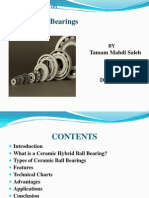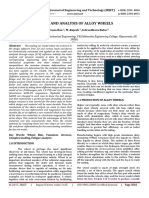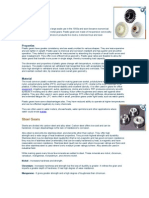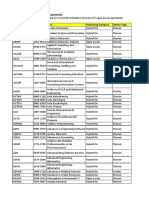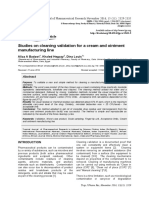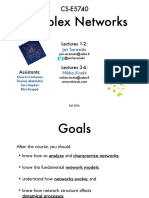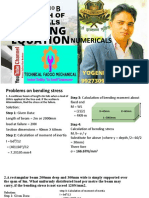0 ratings0% found this document useful (0 votes)
895 viewsCeramic Ball Bearing
Ceramic Ball Bearing
Uploaded by
Durga Prasad KThis document discusses ceramic ball bearings. It begins by providing background on the development of silicon nitride ceramics and their use in bearings. It then defines a ceramic hybrid ball bearing as one made of ceramic elements like silicon nitride. The document describes the three main types of ceramic ball bearings and lists several advantages of ceramic balls over steel balls like lower weight, higher hardness, and corrosion resistance. It provides examples of applications and concludes that ceramic hybrid bearings have longer service life and lower vibration levels than conventional steel ball bearings.
Copyright:
Attribution Non-Commercial (BY-NC)
Available Formats
Download as PPT, PDF, TXT or read online from Scribd
Ceramic Ball Bearing
Ceramic Ball Bearing
Uploaded by
Durga Prasad K0 ratings0% found this document useful (0 votes)
895 views22 pagesThis document discusses ceramic ball bearings. It begins by providing background on the development of silicon nitride ceramics and their use in bearings. It then defines a ceramic hybrid ball bearing as one made of ceramic elements like silicon nitride. The document describes the three main types of ceramic ball bearings and lists several advantages of ceramic balls over steel balls like lower weight, higher hardness, and corrosion resistance. It provides examples of applications and concludes that ceramic hybrid bearings have longer service life and lower vibration levels than conventional steel ball bearings.
Original Title
Ceramic Ball Bearing Ppt
Copyright
© Attribution Non-Commercial (BY-NC)
Available Formats
PPT, PDF, TXT or read online from Scribd
Share this document
Did you find this document useful?
Is this content inappropriate?
This document discusses ceramic ball bearings. It begins by providing background on the development of silicon nitride ceramics and their use in bearings. It then defines a ceramic hybrid ball bearing as one made of ceramic elements like silicon nitride. The document describes the three main types of ceramic ball bearings and lists several advantages of ceramic balls over steel balls like lower weight, higher hardness, and corrosion resistance. It provides examples of applications and concludes that ceramic hybrid bearings have longer service life and lower vibration levels than conventional steel ball bearings.
Copyright:
Attribution Non-Commercial (BY-NC)
Available Formats
Download as PPT, PDF, TXT or read online from Scribd
Download as ppt, pdf, or txt
0 ratings0% found this document useful (0 votes)
895 views22 pagesCeramic Ball Bearing
Ceramic Ball Bearing
Uploaded by
Durga Prasad KThis document discusses ceramic ball bearings. It begins by providing background on the development of silicon nitride ceramics and their use in bearings. It then defines a ceramic hybrid ball bearing as one made of ceramic elements like silicon nitride. The document describes the three main types of ceramic ball bearings and lists several advantages of ceramic balls over steel balls like lower weight, higher hardness, and corrosion resistance. It provides examples of applications and concludes that ceramic hybrid bearings have longer service life and lower vibration levels than conventional steel ball bearings.
Copyright:
Attribution Non-Commercial (BY-NC)
Available Formats
Download as PPT, PDF, TXT or read online from Scribd
Download as ppt, pdf, or txt
You are on page 1of 22
CERAMIC BALL BEARING
-BY ADARSHA KUMAR P G
UNDER THE GUIDANCE OF
AAsst Prof. K M BASAPPAJI M.Tech(Ph.D)
Asst Professor, Dept of Mechanical Engg
JNNCE.
CONTENTS
Introduction
What is a Ceramic Hybrid Ball Bearing?
Types of Ceramic Ball Bearings
Features
Technical Charts
Applications
Conclusion
References
Introduction
Silicon Nitride was developed in 1963 by NASA.
The machine tool industry has been a pioneer in the
use of ceramic hybrid ball bearings
Hi-performance motor racing programs, like Formula-
1, are using ceramic hybrids.
Silicon Nitride ceramic balls are virtually
indestructible, survive in thermal, heavy load, won't
dent or rust, virtually unbreakable and will not wear
or degrade over time.
What is a Ceramic Hybrid Ball Bearing?
We can achieve new
Friction-reducing
Ceramic ball bearings!
A Ceramic Hybrid Ball Bearing made of ceramic elements
from silicon nitride.
Silicon nitride is a highly processed silica and ceramic
material.
The use of Ceramics for bearing components results in a far
superior product.
Types of Ceramic Ball Bearings
Ceramic Hybrid Ball Bearings
Partial Ceramic Ball Bearings
Full Ceramic Ball Bearings
Ceramic Hybrid Ball Bearings
Partial Ceramic Ball Bearings
Full Ceramic Ball Bearings
Features
60% lighter than steel balls.
50% higher modulus of elasticity.
Tribochemically inert.
Non-conductive.
Less maintenance.
Coefficient of Friction.
Low Density.
High Hardness.
High Hot Strength.
Low Coefficient of Thermal Expansion.
Long Fatigue Life.
Corrosion Resistance.
Micro Weld
Micro Weld occurs when microscopic surface
"peaks" on the ball and race make contact and
actually weld together.
This occurs even with light loading and adequate
lubrication.
This results in higher temperatures, higher friction,
and decreased life.
The ceramic hybrid bearing cannot micro-weld to
steel, thus eliminating the problem entirely.
Technical Charts
Applications
Motor Racing.
Motorcycle Racing.
Machine tool applications.
Aircraft accessories/aerospace.
Industrial Machinery.
Medical equipment.
Some of the Ceramic Ball Bearings
Conclusion
Ceramic ball is tremendously harder than steel
(Rockwell 78c versus Rockwell 60c for steel balls).
Ceramic ball is 60% lighter than a steel ball.
Ceramic ball is much less prone to "skid".
Ceramic ball is significantly rounder and has a finer
finish than conventional steel balls.
Operating temperature for ceramic is 2000 degrees F.
versus 600 F. degrees for steel.
Vibration levels of ceramic hybrid bearings average
two to seven times lower than that of steel.
Service life is two to five times longer than
conventional steel ball bearings.
25% of all electrical energy produced is used to
power some type of electric motor. Imagine the
savings in resources if all motors were to run with
ceramic hybrid ball bearings!
References
Elements of machine design by Khurmi.
www.bearingworks.com
www.cbrbearing.com
www.bearing-china.com
www.mcrbearingservices.com
You might also like
- Engine Block Manufacturing ProcessDocument12 pagesEngine Block Manufacturing ProcessFadirul Ezwan100% (3)
- Ceramic-Disc-Brakes ReportDocument17 pagesCeramic-Disc-Brakes ReportArjun Sagar.100% (2)
- Weld Like a Pro: Beginning to Advanced TechniquesFrom EverandWeld Like a Pro: Beginning to Advanced TechniquesRating: 4.5 out of 5 stars4.5/5 (6)
- Investigative Report On The Covid-19 Pandemic and Its Relationship Tu Sars-Cov-2 and Other Factors (Claire Edwards)Document186 pagesInvestigative Report On The Covid-19 Pandemic and Its Relationship Tu Sars-Cov-2 and Other Factors (Claire Edwards)Éditions DédicacesNo ratings yet
- CERAMIC BALL BEARING SeminarDocument22 pagesCERAMIC BALL BEARING Seminartamam82No ratings yet
- CERAMIC BALL BEARING SeminarDocument21 pagesCERAMIC BALL BEARING SeminarSachin Kadwadkar50% (4)
- Ceramic Ball BearingDocument22 pagesCeramic Ball BearingNamratha Cm100% (1)
- Ceramic Ball BearingDocument22 pagesCeramic Ball Bearingrithesh.kNo ratings yet
- Ceramic Ball BearingDocument8 pagesCeramic Ball BearingSachin Kadwadkar100% (1)
- Shoeb 2Document26 pagesShoeb 2Naveen PipperaNo ratings yet
- Vibration Analysis of Hybrid Cyramic Ball BearingsDocument16 pagesVibration Analysis of Hybrid Cyramic Ball BearingsRaghavendra Raghav100% (2)
- Better Workpiece Finish Characteristics. A Doubling of Cutting Tool Life. Overall Improved Accuracy and Reduced Scrap RatesDocument2 pagesBetter Workpiece Finish Characteristics. A Doubling of Cutting Tool Life. Overall Improved Accuracy and Reduced Scrap RatesasasadityaNo ratings yet
- Ceramic Ball BearingsDocument4 pagesCeramic Ball Bearingssuseelaparvathimsp100% (2)
- Akshay CP PresentationDocument20 pagesAkshay CP PresentationAjith KNo ratings yet
- Ceramic BearingDocument42 pagesCeramic BearingSHROUQ GAMALNo ratings yet
- Hybrid Ceramic Ball BearingsDocument15 pagesHybrid Ceramic Ball BearingsManish PatilNo ratings yet
- Ceramic BearingsDocument9 pagesCeramic Bearingssureshnfcl100% (1)
- NSK Ceramic Bearing Lperformance ComparisonDocument6 pagesNSK Ceramic Bearing Lperformance Comparisonanhntran4850No ratings yet
- Comparison of BearingsDocument9 pagesComparison of BearingsMadhu Sri Harsha0% (1)
- 61 5002 8453 6 PowertrainDocument16 pages61 5002 8453 6 PowertrainThuanNo ratings yet
- Experimental Investigation On Zirconia Reinforced Aluminium 6061 Metal Matrix CompositeDocument10 pagesExperimental Investigation On Zirconia Reinforced Aluminium 6061 Metal Matrix CompositeIJRASETPublicationsNo ratings yet
- Irjet V4i6386Document7 pagesIrjet V4i6386MINDWORKZ MECHNo ratings yet
- Mediaibyf2dfgindustry-Catalogue Ver2 en PDFDocument29 pagesMediaibyf2dfgindustry-Catalogue Ver2 en PDFJose Manuel Sánchez LópezNo ratings yet
- Ceramic Disc Brakes 26122012172518 Ceramic Disc BrakesDocument16 pagesCeramic Disc Brakes 26122012172518 Ceramic Disc BrakesMUHAMMED FAISALNo ratings yet
- 2.10.1 Machining Studies On Cast IronDocument14 pages2.10.1 Machining Studies On Cast IronA Senthil KumarNo ratings yet
- Ceramic: From Wikipedia, The Free EncyclopediaDocument5 pagesCeramic: From Wikipedia, The Free EncyclopediaAnas AzizanNo ratings yet
- Assignment 2Document6 pagesAssignment 2Abu ZaloNo ratings yet
- Aluminum BronzeDocument37 pagesAluminum Bronzepipedown456100% (2)
- Disc Brake Rotor Using Aluminium Metal Matrix Composite Reinforced With Silicon CarbideDocument6 pagesDisc Brake Rotor Using Aluminium Metal Matrix Composite Reinforced With Silicon CarbideJoao LuisNo ratings yet
- Fabrication of Aluminium 6061-Sic-Al O MMC and HMMC by Strir Casting Technique and Comparing The Mechanical PropertiesDocument8 pagesFabrication of Aluminium 6061-Sic-Al O MMC and HMMC by Strir Casting Technique and Comparing The Mechanical PropertiesTJPRC PublicationsNo ratings yet
- Disc Brake Analysis: Mechanics of Materials-I Lab ReportDocument17 pagesDisc Brake Analysis: Mechanics of Materials-I Lab ReportakbarNo ratings yet
- Design and Analysis of Alloy Wheel Rim by Using Different MaterialDocument12 pagesDesign and Analysis of Alloy Wheel Rim by Using Different MaterialIJRASETPublicationsNo ratings yet
- Ceramic EngineeringDocument8 pagesCeramic EngineeringahumairNo ratings yet
- SKF Materials For Bearing Rings and Rolling ElementsDocument2 pagesSKF Materials For Bearing Rings and Rolling ElementsKamolwan WeerachatsakulNo ratings yet
- MIE 375 Final ReportDocument8 pagesMIE 375 Final Reportjohn jonesNo ratings yet
- Publication 8Document5 pagesPublication 8MIC MECHNo ratings yet
- Aluminum BronzeDocument37 pagesAluminum Bronzelijojose1No ratings yet
- Nickel Based Superalloys UsesDocument6 pagesNickel Based Superalloys UsesHeanjiaAlloysNo ratings yet
- Structural Analysis of Hybrid Composite PDFDocument8 pagesStructural Analysis of Hybrid Composite PDFCristianNo ratings yet
- 47.design and Analysis of BearingsDocument5 pages47.design and Analysis of BearingsashNo ratings yet
- Selectively Reinforced Squeeze Cast PistonsDocument6 pagesSelectively Reinforced Squeeze Cast PistonsAswath RamNo ratings yet
- PaM Compact Blow-Bars enDocument48 pagesPaM Compact Blow-Bars enDaniel Alejandro Navarro Jara100% (1)
- Case Study: CrankshaftsDocument12 pagesCase Study: CrankshaftsDHRUV SINGHALNo ratings yet
- Copper AlloysDocument4 pagesCopper AlloysBookMaggotNo ratings yet
- Plastic GearsDocument3 pagesPlastic GearssunginnNo ratings yet
- Powered Vegetable Cutting Machine RDocument36 pagesPowered Vegetable Cutting Machine RMubarak ShaikNo ratings yet
- Ceramic Disc BrakesDocument16 pagesCeramic Disc BrakesDibya Sundar Sahoo100% (1)
- Ceramic Bearings (Report)Document7 pagesCeramic Bearings (Report)Mahmoud KassabNo ratings yet
- Light Weight Non-Metals To Replace Steel: A Term Paper OnDocument15 pagesLight Weight Non-Metals To Replace Steel: A Term Paper OnJatinderjot SinghNo ratings yet
- Aluminum Bronze PDFDocument37 pagesAluminum Bronze PDFTi AnnelNo ratings yet
- Dinesh Kumar 2023 Eng. Res. Express 5 022002Document16 pagesDinesh Kumar 2023 Eng. Res. Express 5 022002Joao LuisNo ratings yet
- Tiuuin PDFDocument1 pageTiuuin PDFAshutosh KumarNo ratings yet
- Aluminium Metal Matrix Composite (MMC) Brake RotorDocument15 pagesAluminium Metal Matrix Composite (MMC) Brake RotorDEVANSH JAINNo ratings yet
- Ceramics, Glass, Graphite, Diamond, and Nanomaterials: Structure, General Properties, and ApplicationsDocument26 pagesCeramics, Glass, Graphite, Diamond, and Nanomaterials: Structure, General Properties, and ApplicationsReal MeNo ratings yet
- Ceramic Disc BrakesDocument14 pagesCeramic Disc Brakesmayur_bng75% (4)
- Compressor BearingsDocument4 pagesCompressor BearingsAlejandro SotoNo ratings yet
- Self-healing Ceramic Matrix Composites: A MonographFrom EverandSelf-healing Ceramic Matrix Composites: A MonographNo ratings yet
- Standard Blacksmithing, Horseshoeing and Wagon Making: Containing: Twelve Lessons in Elementary Blacksmithing Adapted to the Demand of Schools and Colleges of Mechanic Arts: Tables, Rules and Receipts Useful to Manufactures, Machinists, Engineers and BlacksmithsFrom EverandStandard Blacksmithing, Horseshoeing and Wagon Making: Containing: Twelve Lessons in Elementary Blacksmithing Adapted to the Demand of Schools and Colleges of Mechanic Arts: Tables, Rules and Receipts Useful to Manufactures, Machinists, Engineers and BlacksmithsNo ratings yet
- Airfield Components and LightingsDocument10 pagesAirfield Components and Lightingsrmaffireschool100% (2)
- Statistics For Management - Assignments SolvedDocument9 pagesStatistics For Management - Assignments Solvednitin_bslNo ratings yet
- Evolution of Thermally Induced White Etching Layer at Rail Surface During Multiple Wheel - Train PassagesDocument13 pagesEvolution of Thermally Induced White Etching Layer at Rail Surface During Multiple Wheel - Train Passagesanime MAVCNo ratings yet
- Prepositions and Numbers RevisionDocument31 pagesPrepositions and Numbers RevisionArija EverdinNo ratings yet
- Vsphere Replication Roles and Permissions 87Document46 pagesVsphere Replication Roles and Permissions 87samsung samsungNo ratings yet
- Dryer: Owner'S ManualDocument100 pagesDryer: Owner'S Manualavo jamNo ratings yet
- FLEXYDocument4 pagesFLEXYmeiem ndrNo ratings yet
- Journal-List PortugalDocument58 pagesJournal-List PortugalJoseNo ratings yet
- KALINGA ARCHITECTURE FinalDocument22 pagesKALINGA ARCHITECTURE FinalStephanieDelaRosaNo ratings yet
- RM400 Wear Part TrainingDocument18 pagesRM400 Wear Part TrainingMp pmNo ratings yet
- JRC JHS 183 User-Manual-2Document32 pagesJRC JHS 183 User-Manual-2Nishant PandyaNo ratings yet
- Hurler Syndrome - EvangelistaDocument10 pagesHurler Syndrome - EvangelistaGabrielle EvangelistaNo ratings yet
- Studies On Cleaning Validation For A Cream and Ointment Manufacturing LineDocument7 pagesStudies On Cleaning Validation For A Cream and Ointment Manufacturing LinesppNo ratings yet
- CN 2016 Lecture1Document46 pagesCN 2016 Lecture1Dr HussainNo ratings yet
- Spiritual Conflict - Volume 3: God's People TriumphantDocument7 pagesSpiritual Conflict - Volume 3: God's People TriumphantBruce Mulenga SimpasaNo ratings yet
- EDSC2019 Scientific ProgramDocument6 pagesEDSC2019 Scientific Programheart911hotmail.comNo ratings yet
- 143 First Assignment QuestionsDocument10 pages143 First Assignment QuestionsanyigbamarkmilbertNo ratings yet
- Tie Dye: Author: Rachel Morgan TheallDocument7 pagesTie Dye: Author: Rachel Morgan Theallsandeep303797No ratings yet
- Bidri ArtDocument4 pagesBidri Artbhavk20No ratings yet
- 2021-10-01 World Coin NewsDocument48 pages2021-10-01 World Coin NewsWalter MaikNo ratings yet
- Region IV-ADocument56 pagesRegion IV-A2B Dominic Jose CarengNo ratings yet
- Febrile Seizure NcbiDocument7 pagesFebrile Seizure NcbiNurul IrhamnaNo ratings yet
- University of Northern Philippines: WWW - Unp.edu - PH CP# 09177148749, 09175785986Document23 pagesUniversity of Northern Philippines: WWW - Unp.edu - PH CP# 09177148749, 09175785986Hanna La MadridNo ratings yet
- Simplified State Space Layers For SequenceDocument35 pagesSimplified State Space Layers For SequenceTanay MaheshwariNo ratings yet
- ART202 Demonstration 2Document6 pagesART202 Demonstration 2AltairNo ratings yet
- National Diploma Quantity SurveyingDocument107 pagesNational Diploma Quantity SurveyingWasif RiazNo ratings yet
- Lect 10 B Numericals On Bending MomentDocument9 pagesLect 10 B Numericals On Bending MomentYogendra KumarNo ratings yet
- Simplified Solution of Space Frame Structures.: Hayen, Charles LeoDocument77 pagesSimplified Solution of Space Frame Structures.: Hayen, Charles LeoJD OngNo ratings yet
- SolutionsDocument32 pagesSolutionsMayuresh PanseNo ratings yet





